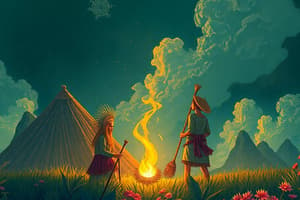Podcast
Questions and Answers
Who is known as an acclaimed kutyapi master?
Who is known as an acclaimed kutyapi master?
- Uwang Ahadas
- Salinta Monon
- Samaon Sulaiman (correct)
- Eduardo Mutuc
Which awardee is celebrated for preserving oral literature?
Which awardee is celebrated for preserving oral literature?
- Darhata Sawabi
- Federico Caballero (correct)
- Lang Dulay
- Alonzo Saclag
What is Alonzo Saclag recognized for?
What is Alonzo Saclag recognized for?
- Epic chanting
- Religious art
- Textile weaving
- Music and dance (correct)
Which awardee specializes in the creation of traditional cloth tapestries?
Which awardee specializes in the creation of traditional cloth tapestries?
Who is recognized for both secular and religious art in materials like silver and bronze?
Who is recognized for both secular and religious art in materials like silver and bronze?
Which textile weaver is noted for the intricate designs of her work?
Which textile weaver is noted for the intricate designs of her work?
Which awardee is also a hands-on teacher of traditional music instruments?
Which awardee is also a hands-on teacher of traditional music instruments?
Where is Lang Dulay from?
Where is Lang Dulay from?
What is the primary purpose of the GAWAD SA MANLILIKHA NG BAYAN (GAMABA) award?
What is the primary purpose of the GAWAD SA MANLILIKHA NG BAYAN (GAMABA) award?
Which of the following is NOT a category under the GAMABA awards?
Which of the following is NOT a category under the GAMABA awards?
What is one of the criteria for selection for the GAMABA award recipients?
What is one of the criteria for selection for the GAMABA award recipients?
What type of medallion is awarded to GAMABA recipients?
What type of medallion is awarded to GAMABA recipients?
How much is the initial grant awarded to a GAMABA awardee?
How much is the initial grant awarded to a GAMABA awardee?
What must GAMABA recipients do with their skills in folk art?
What must GAMABA recipients do with their skills in folk art?
What type of art form did Ginaw Bilog primarily preserve?
What type of art form did Ginaw Bilog primarily preserve?
Which of the following is true about Masino Intaray's contributions?
Which of the following is true about Masino Intaray's contributions?
Flashcards are hidden until you start studying
Study Notes
Gawad sa Manlilikha ng Bayan
- The Gawad sa Manlilikha ng Bayan (GAMABA) is a National Living Treasures Award awarded to Filipino citizens engaged in traditional art.
- This award is given and administered by the National Commission for Culture and the Arts (NCCA).
- The GAMABA recognizes Filipino artists who have achieved a high level of excellence in their traditional art form.
GAMABA Categories
- The GAMABA has categories for various traditional art forms
- Categories include Folk Architecture, Maritime, Transports, Weaving, Carving, Performing Arts, Graphic and Plastic Arts, Ornaments, Textile/Fiber arts, Pottery, Literature, and other expressions of traditional culture.
GAMABA Criteria
- Candidates must be inhabitants of an indigenous community with documented evidence of at least 50 years of practice of a specific folk art tradition.
- They must have consistently produced or performed superior and distinctive works in their art form over a significant period.
- GAMABA awardees must possess mastery of the tools and materials needed by the art form.
- They must have an established reputation as a master craftsman and maker of works of technical quality.
- They must be passing on or willing to pass on their skills to members of their community.
GAMABA Benefits
- GAMABA awardees receive a gold medallion, a grant of PhP 100,000, and a monthly stipend of PhP 10,000.
- The NCCA has formulated guidelines on “inviting a GAMABA awardee” to define the benefits and expectations for participating in events.
- The presence of GAMABA awardees is required in events under the NCCA’s institutional programs and projects.
GAMABA Awardees
- Ginaw Bilog (1993): A Mangyan poet from Oriental Mindoro, recognized for her preservation of the ambahan, a poetic form composed of seven-syllable lines used to convey metaphors.
- Masino Intaray (1993): A Pala’wan musician and storyteller from Palawan, recognized for his mastery of musical instruments such as the basal, kulilal, and bagit, and his mastery of chants like tultul (epics), sudsungit (narratives), and tuturan (myths of origin and teachings of ancestors).
- Samaon Sulaiman (1993): A Maguindanao musician from Maguindanao, recognized as an acclaimed kutyapi master.
- Lang Dulay (1998): A T’boli textile weaver from South Cotabato, recognized for her fine quality yarn and weaving techniques, which produced textiles deemed “excellent”.
- Salinta Monon (1998): A Tagabawa Bagobo textile weaver from Davao del Sur, recognized for her exceptional quality of work and intricate designs.
- Alonzo Saclag (2000): A Kalinga musician and dancer from Kalinga, recognized as a master of dance and the performing arts, whose mission is to foster appreciation of Kalinga culture.
- Federico Caballero (2000): A Sulod-Bukidnon epic chanter from Iloilo, recognized for his tireless work in preserving oral literature, particularly the epics of Labaw Dunggon and Humadapnon. He is considered a Bantugan, a person with attained distinction.
- Uwang Ahadas (2000): A Yakan musician from Basilan, recognized for his hands-on teaching of the kwintangan, kayu, and tuntungan.
- Darhata Sawabi (2004): A Tausug textile weaver from Sulu, recognized for her skill in weaving pis syabit, the traditional cloth tapestry worn as a head cover.
- Eduardo Mutuc (2004): A Tausug textile weaver from Pampanga, recognized for his creation of religious and secular art in silver, bronze, and wood. His works are found in churches and private collections.
Studying That Suits You
Use AI to generate personalized quizzes and flashcards to suit your learning preferences.




